Low-Cost and High-Performance Solution for Positioning and Monitoring of Large Structures
Abstract
:1. Introduction
2. Proposed Solution
- 1.
- The attitude update is first computed through the time derivative of coordinate transformation matrix (body to navigation reference frame) at time according to
- 2.
- Specific force frame transformation that allows computing the measured specific force (acceleration) of the body with respect to inertial space resolved in the current local navigation frame
- 3.
- The velocity vector , is then updated by computing the time derivative of velocity at time according to the following expression,
- 4.
- The position in the local navigation frame is finally updated by computing the time derivative of latitude (, longitude (), and altitude () at time according to the following relationships
- 1.
- Each time new values of acceleration and angular rate are available, the prediction or “Time Update” equations are exploited for the propagation of both the state vector and state error covariance matrix
- 2.
- Each time a new vector zj of position and velocity is available from the GNSS, the correction or “Measurement update” equations are exploited to provide an improved estimate (usually referred to as a posteriori) of the state vector. For this, the Kalman gain (), i.e., a parameter weighting the reliability of the information introduced by the external measurement, is first evaluated according to
- The selected IMU is a tactical-grade MEMS sensor ADIS16495 from Analog DeviceTM that includes, as the sensing unit, both a triaxial digital gyroscope and a triaxial digital accelerometer The gyroscope is characterized by a bias instability equal to 0.8°/h and an angular random walk equal to 0.09°/√h; as for the accelerometer, the datasheet [34] describes a bias instability equal to 3.2 μg and velocity random walk equal to 0.008 m/s/√h. The gyro bias instability sets the selected sensor in the lower bound of the tactical-grade category and represents a proper trade-off between performance and costs;
- The GPS module adopted was ZED-F9P by UbloxTM [35] included in the SparkFunTM GPS-RTK board. The GPS module is equipped with two UART communication serial ports; the first one is demanded to retrieve the RTK correction, and the second one is configured to send position outputs to the microcontroller.
- Communications between the Rover and Base stations are implemented with a certified Bluetooth module by Roving NetworkTM included in the SparkFunTM WRL-12,580 that allows obtaining a stable connection within a range of 100 m and baud rate of up to 921,600 bps for data transmission [36].
- The core of the system was a Nucleo-F446 board from STMicroeletronicsTM with a Cortex-M4-based microcontroller that operates at 180 MHz [37]. The microcontroller of the Rover station is programmed in such a way as to initialize the SPI and UART peripherals and then establish a Bluetooth communication with the Base station. Once the connection is ready, the microcontroller waits for the acquisition start command. In addition, the microcontroller is programmed to check if the warm-up time has elapsed and then start the attitude and position monitoring procedure described above and in Figure 1. Finally, the results are sent to the Base station until a stop command is received. For the sake of clarity, the program executed by the microcontroller in the Rover station is summarized in the flow chart shown in Figure 3.
- The power source is granted by a lithium battery of 22,000 mAh.
3. Prototype Assessment in Laboratory Tests
3.1. Test Conducted in Stationary Conditions
3.2. Test Conducted in Controlled Rotations
4. Prototype Assessment under Emulated Operating Conditions
4.1. Comparison Tests: Stationary Conditions
4.2. Comparison Tests: Dynamic Conditions
5. Conclusions
Author Contributions
Funding
Acknowledgments
Conflicts of Interest
References
- Yu, J.; Meng, X.; Yan, B.; Xu, B.; Fan, Q.; Xie, Y. Global Navigation Satellite System-based Positioning Technology for Structural Health Monitoring: A Review. Struct. Control. Health Monit. 2020, 27, e2467. [Google Scholar] [CrossRef] [Green Version]
- Jiao, P.; Egbe, K.-J.I.; Xie, Y.; Matin Nazar, A.; Alavi, A.H. Piezoelectric Sensing Techniques in Structural Health Monitoring: A State-of-the-Art Review. Sensors 2020, 20, 3730. [Google Scholar] [CrossRef] [PubMed]
- Chybowski, L.; Tomczak, A.; Kozak, M. Measurement Methods in the Operation of Ships and Offshore Facilities. Sensors 2021, 21, 2159. [Google Scholar] [CrossRef] [PubMed]
- Du, Y.; Wu, W.; Wang, Y.; Yue, Q. Prototype Data Analysis on LH11-1 Semisubmersible Platform in South China Sea. In Proceedings of the International Conference on Offshore Mechanics and Arctic Engineering, San Francisco, CA, USA, 8–13 June 2014; American Society of Mechanical Engineers: New York, NY, USA, 2014; Volume 45387, p. V01BT01A053. [Google Scholar]
- Peters, D.J.H.; Zimmer, R.A.; Hein, M.W.; Wang, W.J.; Leverette, S.J.; Bozeman, J.D. Weight Control, Performance Monitoring, and in-Situ Inspection of the TLWP. In Proceedings of the Offshore Technology Conference, Houston, TX, USA, 7–10 May 1990; OnePetro: Richardson, TX, USA, 1990. [Google Scholar]
- Wang, P.; Tian, X.; Peng, T.; Luo, Y. A Review of the State-of-the-Art Developments in the Field Monitoring of Offshore Structures. Ocean. Eng. 2018, 147, 148–164. [Google Scholar] [CrossRef]
- Iervolino, R.; Bonavolontà, F.; Cavallari, A. A Wearable Device for Sport Performance Analysis and Monitoring. In Proceedings of the 2017 IEEE International Workshop on Measurement and Networking (M & N), Naples, Italy, 27–29 September 2017; IEEE: Piscataway, NJ, USA, 2017. [Google Scholar]
- Angrisani, L.; Martire, V.; Marvaso, M.; Peirce, R.; Picardi, A.; Termo, G.; Toni, A.M.; Viola, G.; Zimmaro, A.; Amodio, A.; et al. An Innovative Air Quality Monitoring System Based on Drone and Iot Enabling Technologies. In Proceedings of the 2019 IEEE International Workshop on Metrology for Agriculture and Forestry (MetroAgriFor), Portici, Italy, 24–26 October 2019; IEEE: Piscataway, NJ, USA, 2019. [Google Scholar]
- Ren, Z.; Skjetne, R.; Jiang, Z.; Gao, Z.; Verma, A.S. Integrated GNSS/IMU Hub Motion Estimator for Offshore Wind Turbine Blade Installation. Mech. Syst. Signal Process. 2019, 123, 222–243. [Google Scholar] [CrossRef]
- Liagre, P.; Gupta, H.; Banon, H. Monitoring of Floating Offshore Installations’ Wave Frequency Motions. In Proceedings of the Offshore Technology Conference, Houston, TX, USA, 5–8 May 2008; OnePetro: Richardson, TX, USA, 2008. [Google Scholar]
- Zhu, X.Y. Research and Simulation of FPSO Movement Based on Field Monitoring. Master’s Thesis, Dalian University of Technology, Dalian, China, 2014. [Google Scholar]
- Nie, Z.; Wang, B.; Wang, Z.; He, K. An Offshore Real-Time Precise Point Positioning Technique Based on a Single Set of BeiDou Short-Message Communication Devices. J. Geod. 2020, 94, 78. [Google Scholar] [CrossRef]
- Tian, X.; Wang, P.; Li, X.; Wu, X.; Lu, W.; Wu, C.; Hu, Z.; Rong, H.; Sun, H.; Wang, A. Design and Application of a Monitoring System for the Floatover Installation. Ocean. Eng. 2018, 150, 194–208. [Google Scholar] [CrossRef]
- Wang, Z. Offshore Platform Prototype Monitoring and Modal Analysis of the Mooring Structure. Master’s Thesis, Dalian University of Technology, Dalian, China, 2015. [Google Scholar]
- Groves, P.D. Principles of GNSS, Inertial, and Multisensor Integrated Navigation Systems, 2nd ed.; IEEE Aerospace and Electronic Systems Magazine; IEEE: Piscataway, NJ, USA, 2015. [Google Scholar] [CrossRef]
- Liu, W.; Song, D.; Wang, Z.; Fang, K. Comparative Analysis between Error-State and Full-State Error Estimation for KF-Based IMU/GNSS Integration against IMU Faults. Sensors 2019, 19, 4912. [Google Scholar] [CrossRef] [PubMed] [Green Version]
- Gross, J.; Gu, Y.; Napolitano, M. A Systematic Approach for Extended Kalman Filter Tuning and Low-Cost Inertial Sensor Calibration within a GPS/INS Application. In Proceedings of the AIAA Guidance, Navigation, and Control Conference, Toronto, ON, Canada, 2–5 August 2010. [Google Scholar]
- Andria, G.; Baccigalupi, A.; Borsic, M.; Carbone, P.; Daponte, P.; de Capua, C.; Ferrero, A.; Grimaldi, D.; Liccardo, A.; Locci, N.; et al. Remote Didactic Laboratory “G. Savastano,” The Italian Experience for E-Learning at the Technical Universities in the Field of Electrical and Electronic Measurements: Overview on Didactic Experiments. IEEE Trans. Instrum. Meas. 2007, 56, 1124–1134. [Google Scholar] [CrossRef]
- Qu, Y.; Du, Y.; Wu, W.; Shi, Z.; Yue, Q. Full Scale Measurement of LH11-1 FPS Hull and Mooring System. Ocean. Eng. 2013, 31, 1–8. [Google Scholar]
- Schmidt, G.T. INS/GPS Technology Trends. IEEE Sens. J. 2001, 1, 332–339. [Google Scholar] [CrossRef]
- de Alteriis, G.; Bottino, V.; Conte, C.; Rufino, G.; Schiano Lo Moriello, R. Accurate Attitude Inizialization Procedure Based on MEMS IMU and Magnetometer Integration. In Proceedings of the 2021 IEEE 8th International Workshop on Metrology for AeroSpace (MetroAeroSpace), Naples, Italy, 23–25 June 2021; IEEE: Piscataway, NJ, USA, 2021. [Google Scholar] [CrossRef]
- Fontanella, R.; Accardo, D.; Schiano Lo Moriello, R.; Angrisani, L.; de Simone, D. An Innovative Strategy for Accurate Thermal Compensation of Gyro Bias in Inertial Units by Exploiting a Novel Augmented Kalman Filter. Sensors 2018, 18, 1457. [Google Scholar] [CrossRef] [PubMed] [Green Version]
- Feng, X.; Zhang, T.; Lin, T.; Tang, H.; Niu, X. Implementation and Performance of a Deeply-Coupled GNSS Receiver with Low-Cost MEMS Inertial Sensors for Vehicle Urban Navigation. Sensors 2020, 20, 3397. [Google Scholar] [CrossRef] [PubMed]
- Hasan Ahmed, M.; Samsudin Khairulmizam Ramli Abdul Rahman Azmir, R.S.; Ismaeel, S. A Review of Navigation Systems (Integration and Algorithms). Aust. J. Basic Appl. Sci. 2009, 3, 943–959. [Google Scholar]
- Xu, Q.; Li, X.; Chan, C.Y. Enhancing Localization Accuracy of MEMS-INS/GPS/In-Vehicle Sensors Integration during GPS Outages. IEEE Trans. Instrum. Meas. 2018, 67, 1966–1978. [Google Scholar] [CrossRef]
- De Alteriis, G.; Conte, C.; Schiano Lo Moriello, R.; Accardo, D. Use of Consumer-Grade MEMS Inertial Sensors for Accurate Attitude Determination of Drones. In Proceedings of the 2020 IEEE 7th International Workshop on Metrology for AeroSpace (MetroAeroSpace), Pisa, Italy, 22–24 June 2020; IEEE: Piscataway, NJ, USA, 2020; pp. 534–538. [Google Scholar] [CrossRef]
- Bonavolonta, F.; di Noia, L.P.; Liccardo, A.; Tessitore, S.; Lauria, D. A PSO-MMA Method for the Parameters Estimation of Interarea Oscillations in Electrical Grids. IEEE Trans. Instrum. Meas. 2020, 69, 8853–8865. [Google Scholar] [CrossRef]
- Baccigalupi, A.; Liccardo, A. Compensation of Current Transformers. In Proceedings of the 2007 IEEE Instrumentation & Measurement Technology Conference IMTC 2007, Warsaw, Poland, 1–3 May 2007; IEEE: Piscataway, NJ, USA, 2007; pp. 1–6. [Google Scholar] [CrossRef] [Green Version]
- Park, S.K.; Suh, Y.S. A Zero Velocity Detection Algorithm Using Inertial Sensors for Pedestrian Navigation Systems. Sensors 2010, 10, 9163–9178. [Google Scholar] [CrossRef] [PubMed] [Green Version]
- Fan, Q.; Zhang, H.; Sun, Y.; Zhu, Y.; Zhuang, X.; Jia, J.; Zhang, P. An Optimal Enhanced Kalman Filter for a ZUPT-Aided Pedestrian Positioning Coupling Model. Sensors 2018, 18, 1404. [Google Scholar] [CrossRef] [PubMed] [Green Version]
- Andria, G.; Baccigalupi, A.; Borsic, M.; Carbone, P.; Daponte, P.; de Capua, C.; Ferrero, A.; Grimaldi, D.; Liccardo, A.; Locci, N.; et al. Remote Didactic Laboratory “G. Savastano,” The Italian Experience for E-Learning at the Technical Universities in the Field of Electrical and Electronic Measurement: Architecture and Optimization of the Communication Performance Based on Thin Client Technology. IEEE Trans. Instrum. Meas. 2007, 56, 1124–1134. [Google Scholar] [CrossRef]
- Fontanella, R.; de Alteriis, G.; Schiano Lo Moriello, R.S.; Accardo, D.; Angrisani, L. Results of Field Testing for an Integrated Gps/Ins Unit Based on Low-Cost Redundant Mems Sensors. In Proceedings of the AIAA Scitech 2019 Forum, San Diego, CA, USA, 7–11 January 2019; AIAA: Reston, VA, USA, 2019. [Google Scholar] [CrossRef]
- Conte, C.; de Alteriis, G.; Rufino, G.; Accardo, D. An Innovative Process-Based Mission Management System for Unmanned Vehicles. In Proceedings of the 2020 IEEE 7th International Workshop on Metrology for AeroSpace (MetroAeroSpace), Pisa, Italy, 22–24 June 2020; IEEE: Piscataway, NJ, USA, 2020; pp. 377–381. [Google Scholar] [CrossRef]
- Analog Devices ADIS16495. Available online: https://www.analog.com/en/products/adis16495.html. (accessed on 25 November 2021).
- ublox ZED-F9P. Available online: https://www.u-blox.com/en/product/zed-f9p-module (accessed on 25 November 2021).
- Roving Networks WRL-12580. Available online: https://www.micro-semiconductor.com/datasheet/ee-WRL-12580.pdf (accessed on 25 November 2021).
- STMicroelectronics Nucelo-F446RE. Available online: https://www.st.com/en/evaluation-tools/nucleo-f446re.html (accessed on 25 November 2021).
- KUKA KR 120 R2700. Available online: https://www.kuka.com/-/media/kuka-downloads/imported/6b77eecacfe542d3b736af377562ecaa/0000346518_en.pdf?rev=7afcbd75a8ea4f4fa25a6f3e62fa4387&hash=CF1217DEF3E8B28F4AF696E76F069B53 (accessed on 25 November 2021).
- iXblue Octanse Subsea. Available online: https://www.ixblue.com/products/octans-subsea (accessed on 25 November 2021).


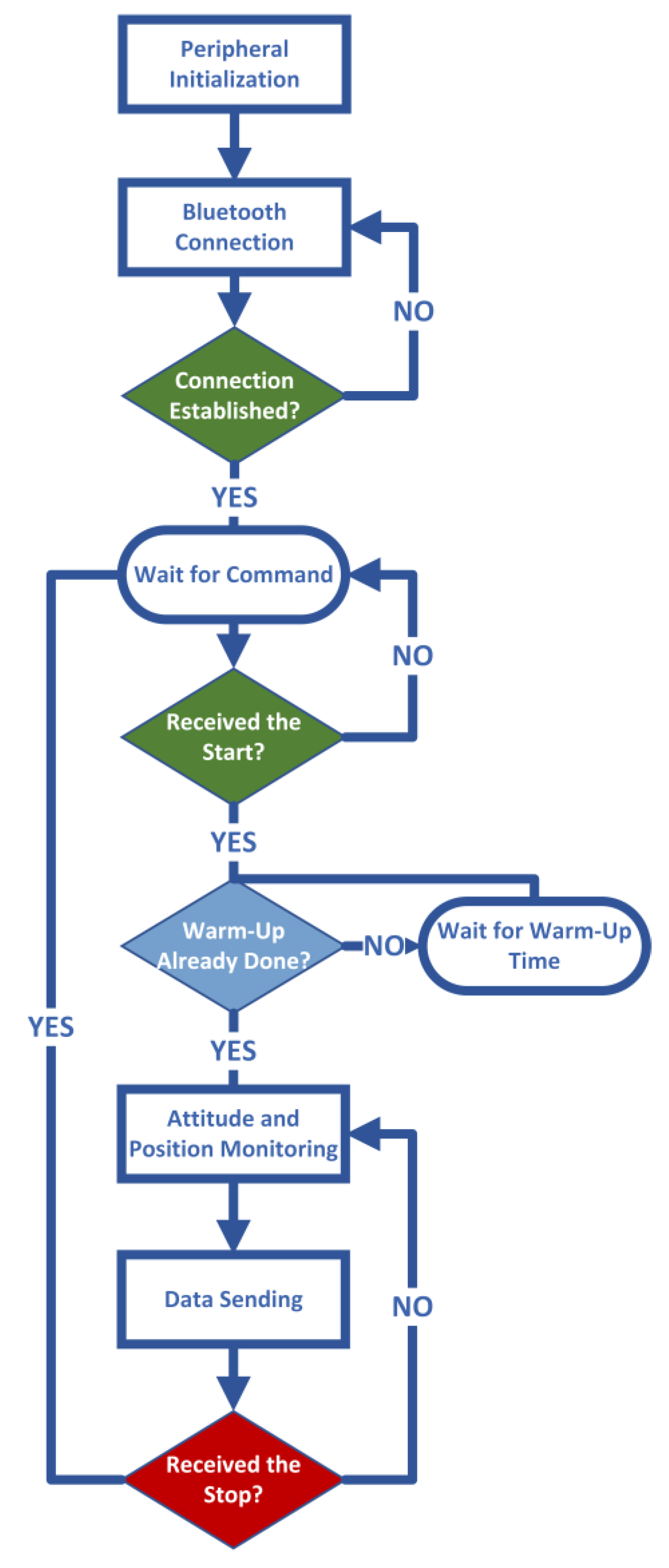
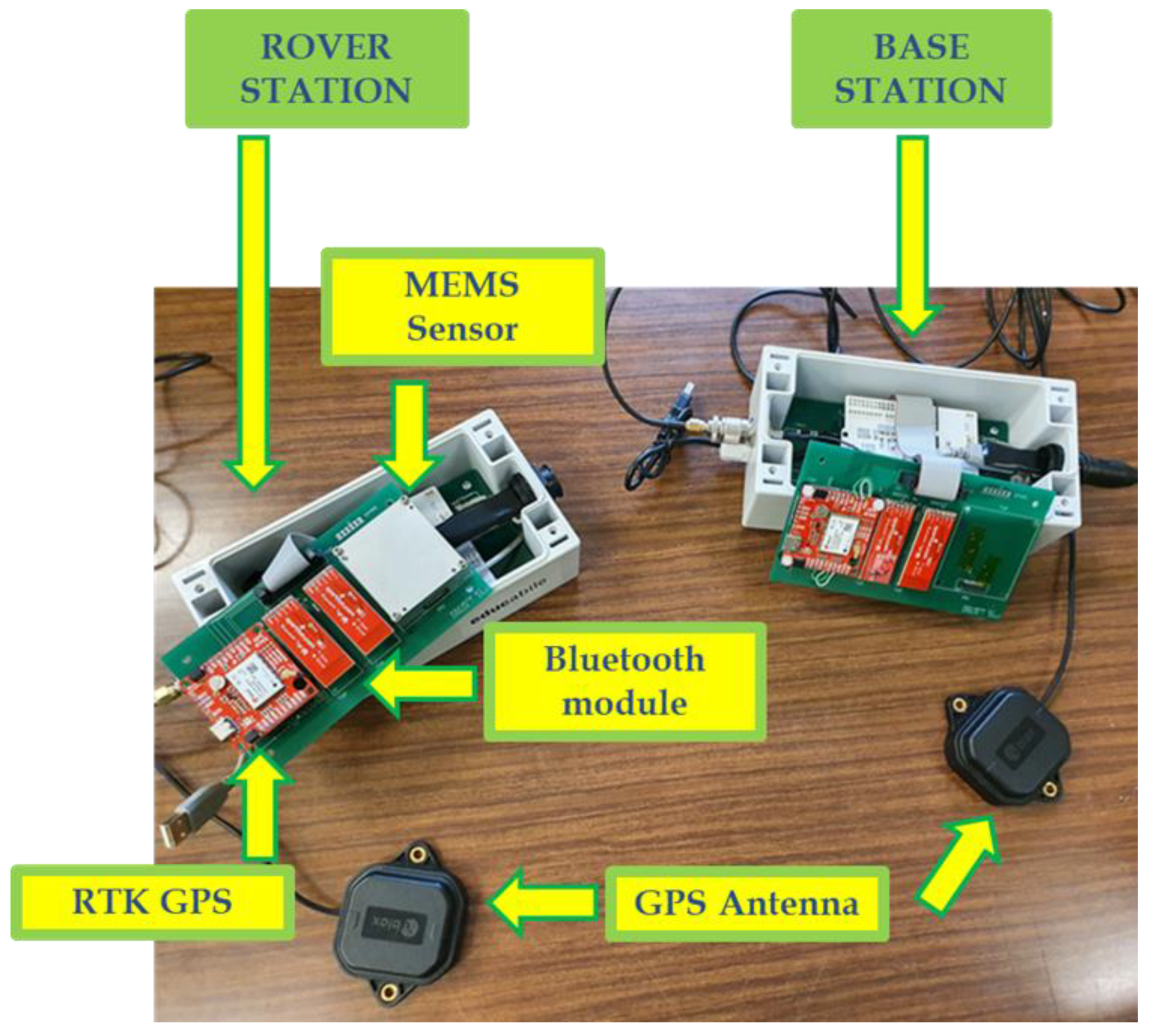
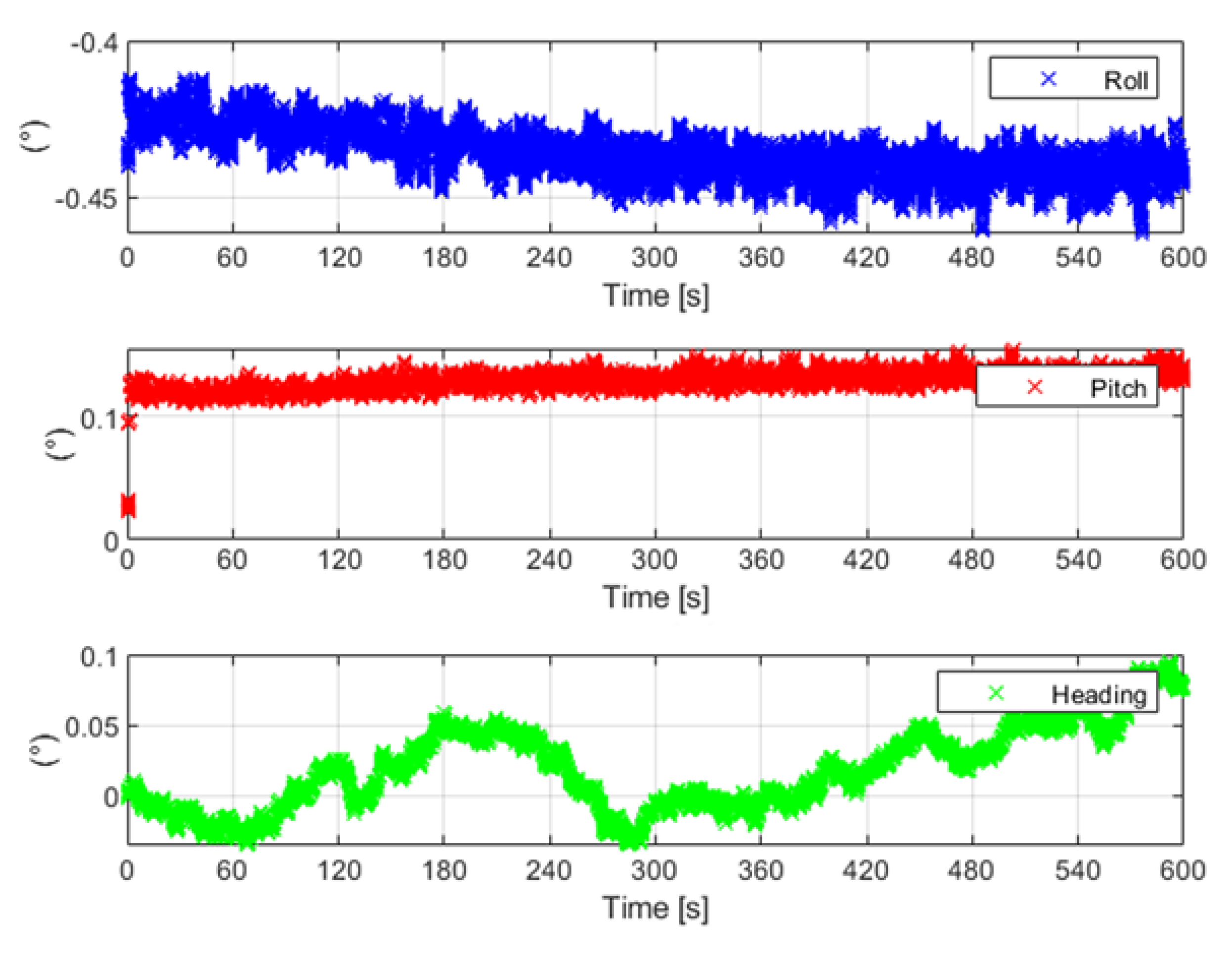


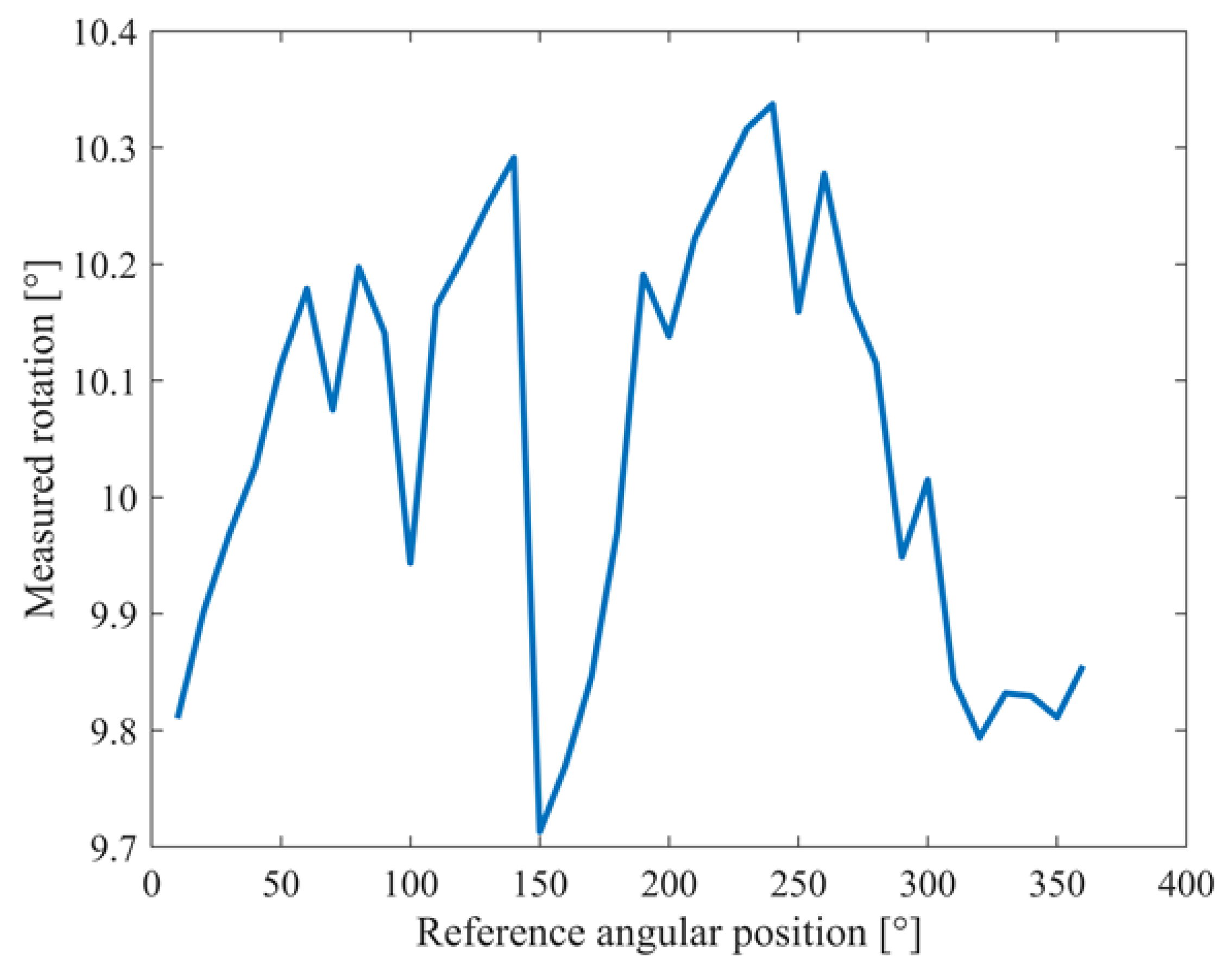
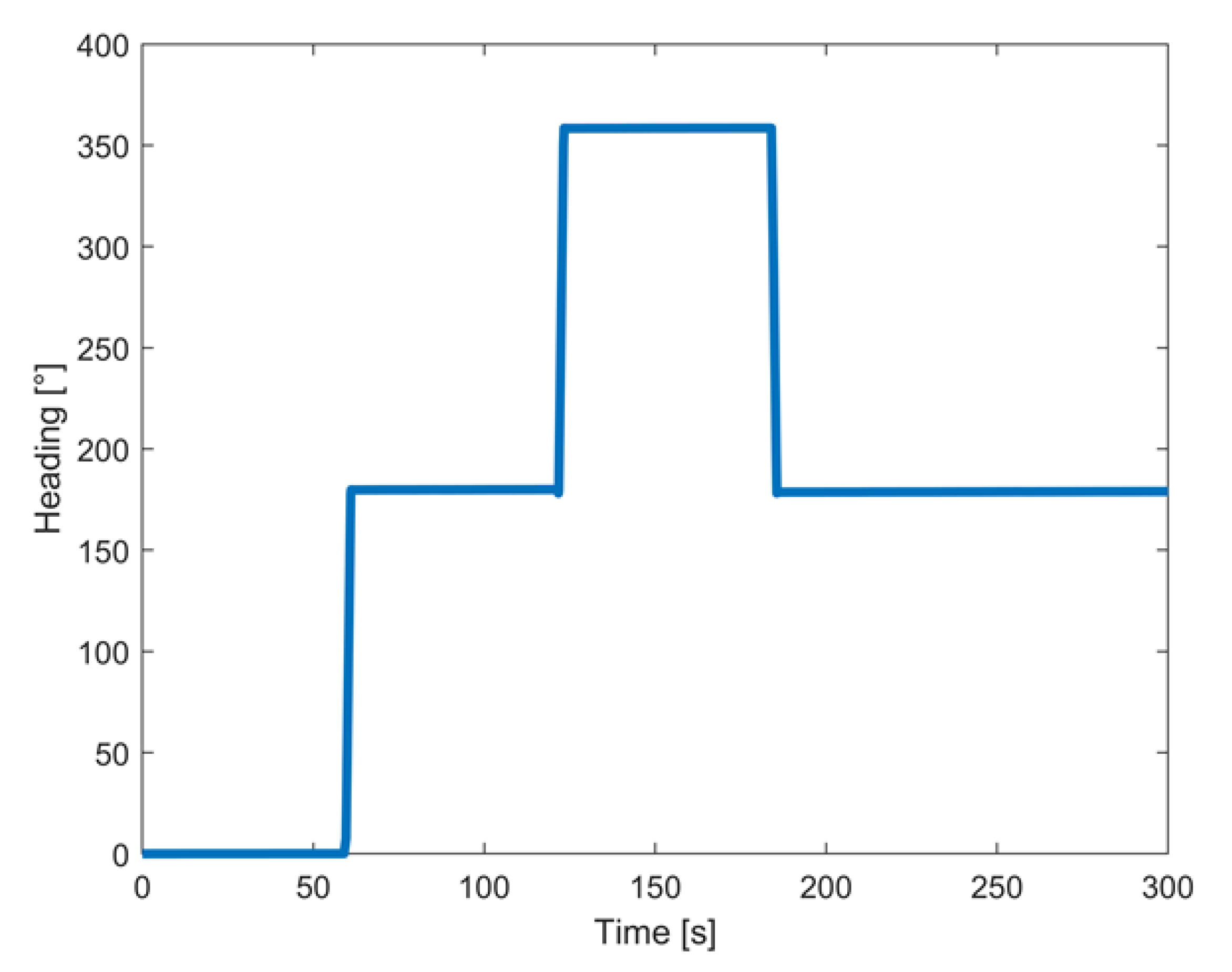
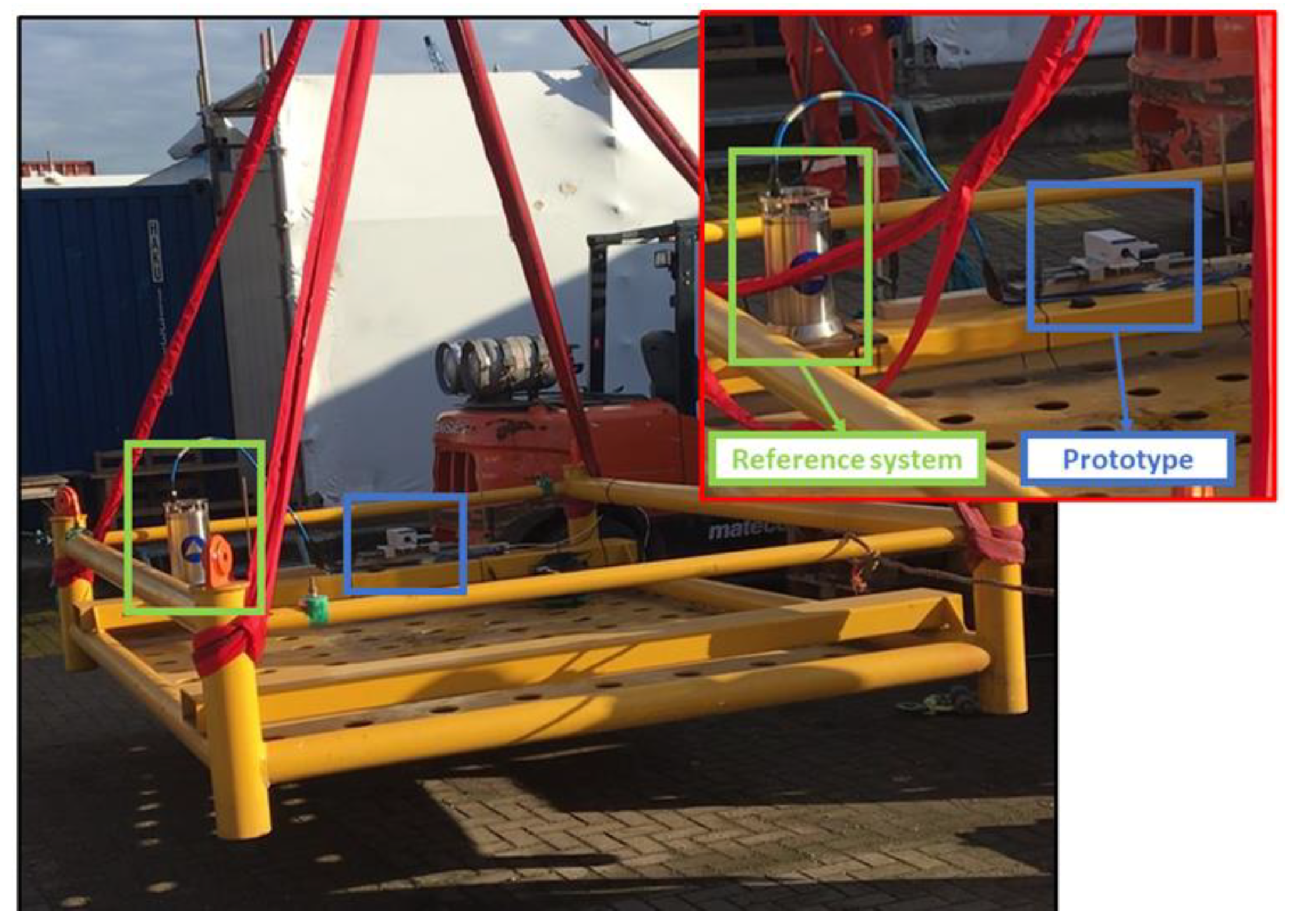
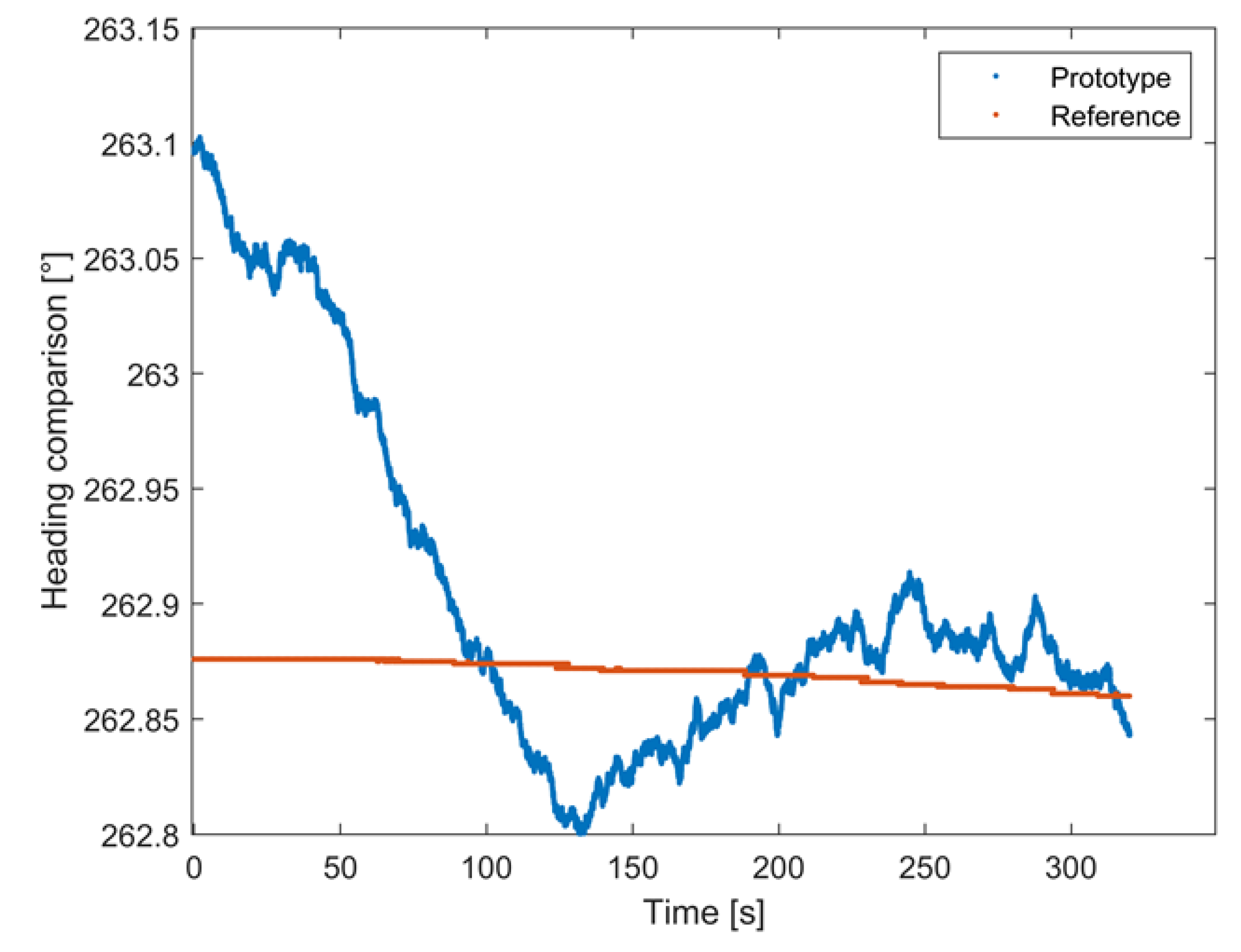
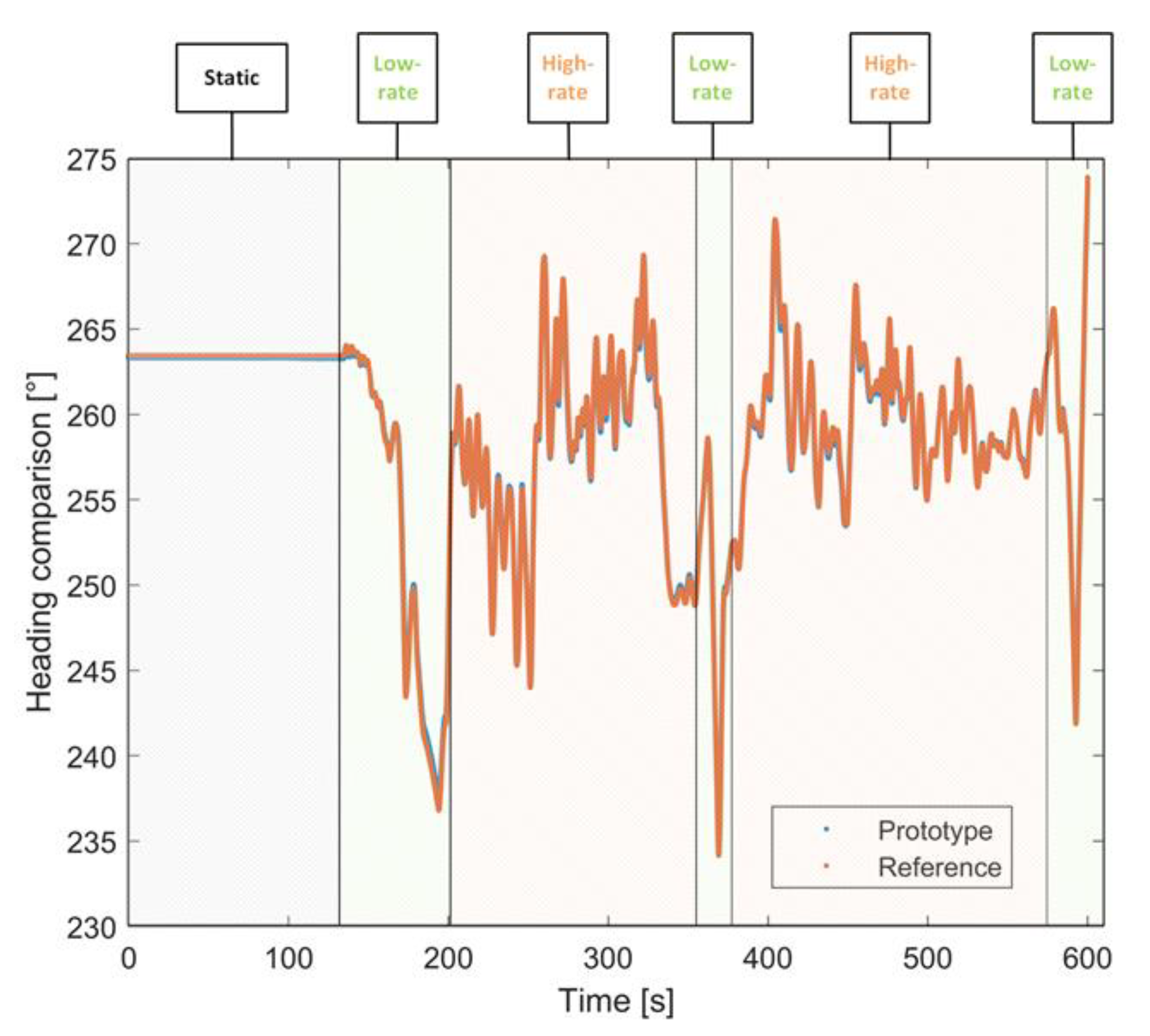

| Angle | Mean Value [°] | STD [°] | RMS [°] |
|---|---|---|---|
| Roll | 0.44 | 0.23 | 0.45 |
| Pitch | 0.13 | 0.11 | 0.13 |
| Heading | 0.06 | 0.04 | 0.05 |
| Output | Degrees (°) |
|---|---|
| Mean Value | 10.04 |
| STD | 0.18 |
| Output | Degrees (°) |
|---|---|
| Mean Value | 0.01 |
| STD | 0.15 |
| Attitude | Mean Value (°) | STD (°) | RMSE (°) |
|---|---|---|---|
| Heading | 0.03 | 0.07 | 0.08 |
| Pitch | 0.07 | 0.34 | 0.35 |
| Roll | 0.22 | 0.31 | 0.38 |
| Angle | Mean Value (%) | STD (%) | RMS (%) | Min Value (%) | Max Value (%) |
|---|---|---|---|---|---|
| Heading | 0.012 | 0.011 | 0.031 | 0.018 | 0.027 |
| Attitude | Mean Value (°) | STD (°) | RMS (°) |
|---|---|---|---|
| Heading | 0.05 | 0.38 | 0.38 |
| Pitch | 0.44 | 0.23 | 0.5 |
| Roll | 0.24 | 0.23 | 0.34 |
| Attitude | Mean Value (%) | STD (%) | RMS (%) | Min Value (%) | Max Value (%) |
|---|---|---|---|---|---|
| Heading | 0.02 | 0.15 | 0.15 | 0.49 | 0.52 |
| Position | Reference (DD) | Mean Value (DD) | Δ Position (DD) |
|---|---|---|---|
| Latitude | 51.9016731 | 51.9016746 | −1.4400 × 10−6 |
| Longitude | 4.390979020 | 4.390974119 | 4.9010 × 10−6 |
Publisher’s Note: MDPI stays neutral with regard to jurisdictional claims in published maps and institutional affiliations. |
© 2022 by the authors. Licensee MDPI, Basel, Switzerland. This article is an open access article distributed under the terms and conditions of the Creative Commons Attribution (CC BY) license (https://creativecommons.org/licenses/by/4.0/).
Share and Cite
de Alteriis, G.; Conte, C.; Caputo, E.; Chiariotti, P.; Accardo, D.; Cigada, A.; Schiano Lo Moriello, R. Low-Cost and High-Performance Solution for Positioning and Monitoring of Large Structures. Sensors 2022, 22, 1788. https://doi.org/10.3390/s22051788
de Alteriis G, Conte C, Caputo E, Chiariotti P, Accardo D, Cigada A, Schiano Lo Moriello R. Low-Cost and High-Performance Solution for Positioning and Monitoring of Large Structures. Sensors. 2022; 22(5):1788. https://doi.org/10.3390/s22051788
Chicago/Turabian Stylede Alteriis, Giorgio, Claudia Conte, Enzo Caputo, Paolo Chiariotti, Domenico Accardo, Alfredo Cigada, and Rosario Schiano Lo Moriello. 2022. "Low-Cost and High-Performance Solution for Positioning and Monitoring of Large Structures" Sensors 22, no. 5: 1788. https://doi.org/10.3390/s22051788
APA Stylede Alteriis, G., Conte, C., Caputo, E., Chiariotti, P., Accardo, D., Cigada, A., & Schiano Lo Moriello, R. (2022). Low-Cost and High-Performance Solution for Positioning and Monitoring of Large Structures. Sensors, 22(5), 1788. https://doi.org/10.3390/s22051788










